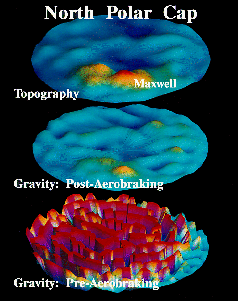
NOTE: Click on the image to view it at its highest resolution.
P-43264
December 6, 1993
In August 1993, the Magellan spacecraft completed a 70-day highly successful aerobraking sequence which changed the spacecraft's elliptical orbit around Venus to a near circular orbit with an apoapsis -- or farthest point from the planet -- of 550 kilometers (341 miles). As a result gravity data resolution was improved for the high latitude regions. Magellan has to date acquired about one-third of the total global coverage from this new circular orbit. Complete coverage may be obtained by the summer of 1994, but with a sizable data gap due to solar conjunction in January 1994. Conjunction occurs when Earth and Venus are on opposite sides of the sun. The present coverage resolves two major areas of Venus, Lakshmi and Maxwell Montes. Maxwell is the highest region of the planet and is of critical importance to geophysicists who must know the gravity field to make realistic inferences about the planet's internal structure. This figure shows a comparison between gravity data over the north polar cap (50 degrees to 90 degrees north) obtained prior to and after aerobraking. The top image displays topographic relief with the bright red peak being Maxwell Montes. The middle image showing data from the near circular orbit, is vastly improved over that collected prior to aerobreaking (bottom image). The new data correlate very well with the topography around Lakshmi and Maxwell. That new data have caused some geophysicists to revise theories regarding this highland region. Their initial thoughts were that the amplitude of the gravity variations would be significantly larger, possibly closer to that of the areas known as Beta and Atla (areas thought to be associated with mantle upwelling). The strength of gravity variations are in fact much smaller and more akin to the Aphrodite region (an area of possibly thickened crust). This indicates that the subsurface structure and processes of formation of this polar region may differ from Beta and Atla.

